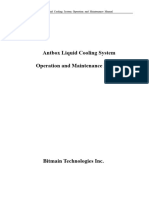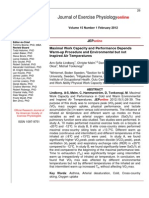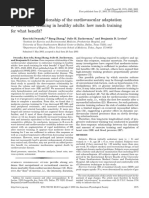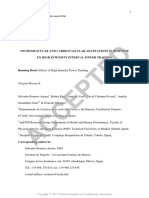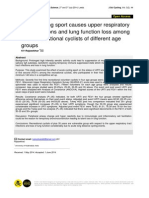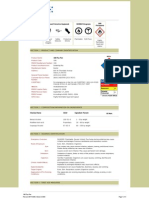Effect of Environmental Temperature On Pacing During A Simulated 16 KM Cycling Time Trial
Effect of Environmental Temperature On Pacing During A Simulated 16 KM Cycling Time Trial
Uploaded by
CristianLopezCopyright:
Available Formats
Effect of Environmental Temperature On Pacing During A Simulated 16 KM Cycling Time Trial
Effect of Environmental Temperature On Pacing During A Simulated 16 KM Cycling Time Trial
Uploaded by
CristianLopezOriginal Title
Copyright
Available Formats
Share this document
Did you find this document useful?
Is this content inappropriate?
Copyright:
Available Formats
Effect of Environmental Temperature On Pacing During A Simulated 16 KM Cycling Time Trial
Effect of Environmental Temperature On Pacing During A Simulated 16 KM Cycling Time Trial
Uploaded by
CristianLopezCopyright:
Available Formats
2nd World Congress of Cycling Science, 2nd and 3rd July 2014, Leeds
BOOK OF ABSTRACTS
J Sci Cycling. Vol. 3(2), 38
Open Access
Effect of environmental temperature on
pacing during a simulated 16 km cycling time
trial
S Bailey and C O'Hagan
1
Abstract
Background: In cycling time trials (TT) the aim is to produce greatest average power possible for the duration of the
effort; to do this an athlete must distribute their effort efficiently to ensure that they do not fatigue early but finish the
event having exhausted their energy stores (Atkinson et al, 2007: Sports Medicine, 37, 647-667). This distribution of
effort is initially determined by conscious control (selection of a pacing strategy), but is influenced by afferent
feedback from both internal sensations and environmental factors (St. Clair Gibson & Noakes, 2004: British Journal
of Sports Medicine, 38, 797-806). Performance in prolonged endurance exercise is inversely related to
environmental temperature; this is thought to be due to central nervous system regulation of effort in response to
increased core temperature. While this negative effect of hot conditions on TT performance is well established, less
is known about the effect of environmental temperature on pacing during TT efforts, in particular in short time trials
which are common in amateur cycling as well as in professional stage races such as the Grand Tours.
Purpose: The aim of this study was to examine the effect of environmental temperature on performance and pacing
during a simulated 16 km cycling time trial.
Methods: After familiarisation, six moderately trained male cyclists (age (mean s) 20 1 year; VO2max 45.3 7.3
ml.kg-1.min-1, power at VO2max 312 28 W) completed self-paced 22-minute trials on an electromagneticallybraked cycle ergometer in hot (30C, HOT) and temperate (15C, COOL) conditions. Participants were instructed to
complete as much work as possible during the trial and the only feedback provided was cadence and time with 5
and 1 minute remaining. Heart rate, core temperature and rate of perceived exertion were recorded at two minute
intervals.
Results: Mean power was slightly lower in HOT than COOL (201 38 W vs. 209 43 W); the difference was not
significant. Core temperature and heart rate were both significantly higher in HOT than COOL (temperature: 37.3
0.5 C vs. 36.4 0.9 C; heart rate: 173 7 bpm vs. 166 11 bpm); rating of perceived exertion did not differ
between the two conditions. Pacing appeared to differ slightly: when power output was compared across four
quarters of the time trial the athletes adopted a positive split with end-spurt in HOT (Q1: 103% overall mean power,
Q2: 100%, Q3: 97%, Q4: 100%) and a negative split with end-spurt in COOL (Q1: 97% overall mean power, Q2:
98%, Q3: 99%, Q4: 107%); the difference was significant in the last quarter.
Discussion: The main outcome of this study was that pacing strategy differed slightly with environmental conditions,
despite relatively similar overall performances in both trials. The effect of environmental conditions on pacing and
the mechanisms involved warrant further investigation, given the important of pacing in successful time trial
performance for athletes who train and compete under a range of environmental conditions.
Contact email: c.ohagan@shu.ac.uk
(C O'Hagan)
Academy of Sport and Physical Activity, Sheffield Hallam University,
United Kingdom
__________________________________________________
Received: 1 May 2014. Accepted: 1 June 2014.
2014 2nd World Congress of Cycling Science, 2nd and 3rd July 2014, Leedst; licensee JSC. This is an Open Access article distributed under the
terms of the Creative Commons Attribution License (http://creativecommons.org/licenses/by/3.0/), which permits unrestricted use, distribution, and
reproduction in any medium, provided the original work is properly cited.
You might also like
- 02-1 - Antbox Liquid Cooling System Operation and Maintenance Manual V1.4Document41 pages02-1 - Antbox Liquid Cooling System Operation and Maintenance Manual V1.4Гаухар СадыковаNo ratings yet
- HIIT VO2 ResearchDocument6 pagesHIIT VO2 Researchapi-3700413No ratings yet
- Why Diets Make Us Fat by Sandra Aamodt, PHDDocument8 pagesWhy Diets Make Us Fat by Sandra Aamodt, PHDsimasNo ratings yet
- Bayer-Monsanto Deal AnalysisDocument4 pagesBayer-Monsanto Deal AnalysisAHMED MOHAMMED SADAQAT PGP 2018-20 Batch0% (1)
- Ironman Pacing Strategy PDFDocument9 pagesIronman Pacing Strategy PDFRonald GeorgeNo ratings yet
- Interval Training Program Optimization in Highly Trained Endurance CyclistsDocument7 pagesInterval Training Program Optimization in Highly Trained Endurance CyclistsAndrea RizzoliNo ratings yet
- BR J Sports Med 1999 Marsh 393 7Document6 pagesBR J Sports Med 1999 Marsh 393 7eliottwolNo ratings yet
- Articulo FTPDocument10 pagesArticulo FTPCristianLopezNo ratings yet
- Deshidratacion CiclismoDocument7 pagesDeshidratacion CiclismoCristianLopezNo ratings yet
- ARTICLE-Effects of A Wheelchair Ergometer Training Programme On SpinalDocument6 pagesARTICLE-Effects of A Wheelchair Ergometer Training Programme On SpinalavalosheNo ratings yet
- Full Text: Physiological Profile of Chris FroomeDocument35 pagesFull Text: Physiological Profile of Chris FroomeNanci GuestNo ratings yet
- Pre-Cooling For Endurance Exercise Performance in The Heat: A Systematic ReviewDocument19 pagesPre-Cooling For Endurance Exercise Performance in The Heat: A Systematic ReviewLanieGeronaNo ratings yet
- Avaliacao 03Document7 pagesAvaliacao 03tralalaNo ratings yet
- Do Hockey Players Need Aerobic Fitness. Relation Between Vo2max and Fatigue During High-Intensity Intermittent Ice Skating 2007Document4 pagesDo Hockey Players Need Aerobic Fitness. Relation Between Vo2max and Fatigue During High-Intensity Intermittent Ice Skating 2007CharlotteEngNo ratings yet
- Effects of A Race Timer On The 3MT For Critical PowerDocument8 pagesEffects of A Race Timer On The 3MT For Critical PowerLéaNo ratings yet
- Gross Efficiency Is Improved in Standing Position With An Increase of The Power OutputDocument1 pageGross Efficiency Is Improved in Standing Position With An Increase of The Power OutputCristianLopezNo ratings yet
- Physiological Demands of Trampolining at Different IntensitiesDocument7 pagesPhysiological Demands of Trampolining at Different IntensitiesTane ClementNo ratings yet
- Oxygen Uptake Kinetics During Treadmill Running Across Exercise Intensity DomainsDocument9 pagesOxygen Uptake Kinetics During Treadmill Running Across Exercise Intensity DomainsPaulo PiresNo ratings yet
- Changes in Cycling Efficiency and PerformanceDocument7 pagesChanges in Cycling Efficiency and PerformanceSanto CrisafulliNo ratings yet
- TharpDocument5 pagesTharpafaifiaatefNo ratings yet
- Effects of Different Warm-Up Protocols On Leg Press One Repetition Maximum Performance (#442587) - 504645Document10 pagesEffects of Different Warm-Up Protocols On Leg Press One Repetition Maximum Performance (#442587) - 504645hilahopNo ratings yet
- Effects of A Seven Day Period of High-Intensity Training On Performance and Physiology of Competitive CyclistsDocument1 pageEffects of A Seven Day Period of High-Intensity Training On Performance and Physiology of Competitive CyclistsCristianLopezNo ratings yet
- Calculation of Power Output and QuantificationDocument16 pagesCalculation of Power Output and Quantificationst_luiseNo ratings yet
- Protocol For The Conconi Test and Determination of The Heart Rate Deflection PointDocument3 pagesProtocol For The Conconi Test and Determination of The Heart Rate Deflection PointLGGNo ratings yet
- oxida Gordura Ciclox Corrida EnglishDocument6 pagesoxida Gordura Ciclox Corrida Englishalinenutri90No ratings yet
- Heart Rate As A Measure of Exercise Testing Early After Acquired Brain InjuryDocument5 pagesHeart Rate As A Measure of Exercise Testing Early After Acquired Brain InjuryJaviera Soto AndradeNo ratings yet
- Polarized Training-Intensity Distribution Leads To Greater Physiological and Performance AdaptationsDocument11 pagesPolarized Training-Intensity Distribution Leads To Greater Physiological and Performance AdaptationsLeonardoValenzuela0% (1)
- 2007 JSS 25 629 634Document6 pages2007 JSS 25 629 634Manoella SilvaNo ratings yet
- A Field-Based Cycling Test To Assess Predictors of Endurance Performance and Establishing Training Zones - DAJO - SANDERSDocument22 pagesA Field-Based Cycling Test To Assess Predictors of Endurance Performance and Establishing Training Zones - DAJO - SANDERSdaniellopes.tvrNo ratings yet
- Comparing Time-Trial and Time To Exhaustion Performance: Book of AbstractsDocument1 pageComparing Time-Trial and Time To Exhaustion Performance: Book of AbstractsCristianLopezNo ratings yet
- Individualised Training Duration Induces Similar Physiological and Performance Benefits at Different IntensitiesDocument1 pageIndividualised Training Duration Induces Similar Physiological and Performance Benefits at Different IntensitiesCristianLopezNo ratings yet
- Heat StressDocument16 pagesHeat StressTimay BuenvenidaNo ratings yet
- fphys-12-692622Document8 pagesfphys-12-692622Fayed AzzaliNo ratings yet
- Do Core Stabilization Exercises Enhance Cycling Efficiency?: Book of AbstractsDocument1 pageDo Core Stabilization Exercises Enhance Cycling Efficiency?: Book of AbstractsCristianLopezNo ratings yet
- The Reliability of Cycling EfficiencyDocument7 pagesThe Reliability of Cycling EfficiencyFabian Rodriguez LopezNo ratings yet
- Energy Cost and Metabolic Power in Elite Soccer A New Match Analysis ApproachDocument9 pagesEnergy Cost and Metabolic Power in Elite Soccer A New Match Analysis Approachjeduardo48No ratings yet
- Specific Warm-Up Enhances Movement Velocity During Bench Press and Squat Resistance TrainingDocument8 pagesSpecific Warm-Up Enhances Movement Velocity During Bench Press and Squat Resistance Trainingribeiro.aikido4736No ratings yet
- Physiological Requirements of Judo CombatDocument8 pagesPhysiological Requirements of Judo Combateverlord123No ratings yet
- Fernando Fábio BucheleitDocument23 pagesFernando Fábio BucheleitFernando De OliveiraNo ratings yet
- Journal of Exercise Physiology: OnlineDocument14 pagesJournal of Exercise Physiology: OnlineTommy BooneNo ratings yet
- Reducing The Intensity and Volume of Interval Training 1min X 1 MinDocument8 pagesReducing The Intensity and Volume of Interval Training 1min X 1 MinEduardo VieyraNo ratings yet
- Air Velocity Influences Thermoregulation and Endurance Exercise Capacity in The HeatDocument9 pagesAir Velocity Influences Thermoregulation and Endurance Exercise Capacity in The HeatMaríaNo ratings yet
- Cyclist ProfileDocument10 pagesCyclist Profilehss HNo ratings yet
- 35 - 2WCSCDocument1 page35 - 2WCSCCristianLopezNo ratings yet
- Effect of Five-Week Preparatory Training Period On Aerobic and Anaerobic Performance of Male Judo AthletesDocument5 pagesEffect of Five-Week Preparatory Training Period On Aerobic and Anaerobic Performance of Male Judo AthletesdserraNo ratings yet
- Even-Pacing StrategyDocument10 pagesEven-Pacing StrategyCristianLopezNo ratings yet
- Does The Addition of Lower-Body Aerobic Exercise As A Warm-Up Improve Upper-Body Resistance Training Performance More Than A Specific Warm-Up AloneDocument5 pagesDoes The Addition of Lower-Body Aerobic Exercise As A Warm-Up Improve Upper-Body Resistance Training Performance More Than A Specific Warm-Up Aloneexco1327No ratings yet
- Kayihan Et Al. 2013Document3 pagesKayihan Et Al. 2013Taha IliasNo ratings yet
- Dose-Response Relationship of The Cardiovascular Adaptation To Endurance Training in Healthy Adults: How Much Training For What Benefit?Document9 pagesDose-Response Relationship of The Cardiovascular Adaptation To Endurance Training in Healthy Adults: How Much Training For What Benefit?Choiri Khumaidah FikriyahNo ratings yet
- CK TriathlonDocument8 pagesCK TriathlonAnderson Pontes MoralesNo ratings yet
- Standing-Based of Fice Work Shows Encouraging Signs of Attenuating Post-Prandial Glycaemic ExcursionDocument4 pagesStanding-Based of Fice Work Shows Encouraging Signs of Attenuating Post-Prandial Glycaemic ExcursionBerta BodaNo ratings yet
- Laforgia 1997Document7 pagesLaforgia 1997volmedo28No ratings yet
- Block Periodization of High-Intensity Aerobic Intervals Provides Superior Training Effects in Trained CyclistsDocument9 pagesBlock Periodization of High-Intensity Aerobic Intervals Provides Superior Training Effects in Trained Cyclistsأحمد ابراهيمNo ratings yet
- The Role of Specific Warm-Up During Bench Press and Squat Exercises A Novel ApproachDocument15 pagesThe Role of Specific Warm-Up During Bench Press and Squat Exercises A Novel Approachribeiro.aikido4736No ratings yet
- Breil Et Al. (2010) - Block Periodization in Alpine Skiing - Effects of 11 Day HIT On VO2max and PerformanceDocument10 pagesBreil Et Al. (2010) - Block Periodization in Alpine Skiing - Effects of 11 Day HIT On VO2max and PerformanceAnaNo ratings yet
- Investigating The Effect of Bouncing Type On The Physiological Demands of TrampoliningDocument7 pagesInvestigating The Effect of Bouncing Type On The Physiological Demands of TrampoliningTane ClementNo ratings yet
- CHO + PRO Antes Do Ciclismo 2011 - Amanda ScagnolatoDocument11 pagesCHO + PRO Antes Do Ciclismo 2011 - Amanda ScagnolatoMagno FilhoNo ratings yet
- Do 3-Min All-Out Test Parameters Accurately Predict Competitive Cyclist Performance in The Severe Intensity Domain?Document1 pageDo 3-Min All-Out Test Parameters Accurately Predict Competitive Cyclist Performance in The Severe Intensity Domain?CristianLopezNo ratings yet
- Heat Adaptation For Females: A Systematic Review and Meta Analysis of Physiological Adaptations and Exercise Performance in The HeatDocument27 pagesHeat Adaptation For Females: A Systematic Review and Meta Analysis of Physiological Adaptations and Exercise Performance in The HeatG oNo ratings yet
- Absctrac Congreso NSCADocument144 pagesAbsctrac Congreso NSCAMelina LabroneNo ratings yet
- Interval and Strength Training in CAD Patients: AuthorsDocument6 pagesInterval and Strength Training in CAD Patients: AuthorsTito AlhoNo ratings yet
- JSC 0000000000001778 PDFDocument28 pagesJSC 0000000000001778 PDFDanielBCNo ratings yet
- The Effect of Wheel Diameter On Vertical and Horizontal Mountain Bike PositionDocument1 pageThe Effect of Wheel Diameter On Vertical and Horizontal Mountain Bike PositionCristianLopezNo ratings yet
- 44 - 2WCSCDocument1 page44 - 2WCSCCristianLopezNo ratings yet
- 41 - 2WCSCDocument1 page41 - 2WCSCCristianLopezNo ratings yet
- Effects of A Seven Day Period of High-Intensity Training On Performance and Physiology of Competitive CyclistsDocument1 pageEffects of A Seven Day Period of High-Intensity Training On Performance and Physiology of Competitive CyclistsCristianLopezNo ratings yet
- Comparing Time-Trial and Time To Exhaustion Performance: Book of AbstractsDocument1 pageComparing Time-Trial and Time To Exhaustion Performance: Book of AbstractsCristianLopezNo ratings yet
- 35 - 2WCSCDocument1 page35 - 2WCSCCristianLopezNo ratings yet
- Do 3-Min All-Out Test Parameters Accurately Predict Competitive Cyclist Performance in The Severe Intensity Domain?Document1 pageDo 3-Min All-Out Test Parameters Accurately Predict Competitive Cyclist Performance in The Severe Intensity Domain?CristianLopezNo ratings yet
- Past Attempts To Identify A Single Physiological Parameter As The Main Indicator of Success in The Tour de France Seem To Have FailedDocument2 pagesPast Attempts To Identify A Single Physiological Parameter As The Main Indicator of Success in The Tour de France Seem To Have FailedCristianLopezNo ratings yet
- 26 - 2WCSCDocument1 page26 - 2WCSCCristianLopezNo ratings yet
- Relation Between Lactic Acid Steady-State and Muscle Oxygenation in Elite CyclistsDocument3 pagesRelation Between Lactic Acid Steady-State and Muscle Oxygenation in Elite CyclistsCristianLopezNo ratings yet
- Modelling of Critical Power From Road DataDocument2 pagesModelling of Critical Power From Road DataCristianLopezNo ratings yet
- 20 - 2WCSCDocument1 page20 - 2WCSCCristianLopezNo ratings yet
- Measures of Training Stress in Cyclists Do Not Usefully Predict Maximum Mean Power in CompetitionsDocument1 pageMeasures of Training Stress in Cyclists Do Not Usefully Predict Maximum Mean Power in CompetitionsCristianLopezNo ratings yet
- Individualised Training Duration Induces Similar Physiological and Performance Benefits at Different IntensitiesDocument1 pageIndividualised Training Duration Induces Similar Physiological and Performance Benefits at Different IntensitiesCristianLopezNo ratings yet
- Gross Efficiency Is Improved in Standing Position With An Increase of The Power OutputDocument1 pageGross Efficiency Is Improved in Standing Position With An Increase of The Power OutputCristianLopezNo ratings yet
- Relationship Between Leg Length and Trunk Orientation in CyclingDocument1 pageRelationship Between Leg Length and Trunk Orientation in CyclingCristianLopezNo ratings yet
- The Analysis & Forecasting of British Cycling Time Trial RecordsDocument1 pageThe Analysis & Forecasting of British Cycling Time Trial RecordsCristianLopezNo ratings yet
- Cupping Therapy in Brief by Shuaib SuriaDocument8 pagesCupping Therapy in Brief by Shuaib SuriaHussein A Bataineh100% (2)
- Integrated Management System Manual: September 2016Document37 pagesIntegrated Management System Manual: September 2016Raul Perez100% (1)
- CNG Tank DevelopmentDocument98 pagesCNG Tank Developmentjunrey paracuellesNo ratings yet
- s6 Halogen TestDocument4 pagess6 Halogen Testzawayarobert45No ratings yet
- Supplier Pre-Qualification Assessment Form - Rev.02Document18 pagesSupplier Pre-Qualification Assessment Form - Rev.02cpsinasNo ratings yet
- Soal PTS Big 7 GenapDocument4 pagesSoal PTS Big 7 GenapAnang Mahmudi100% (1)
- The Palace Senior Living Assisted Living MiamiDocument1 pageThe Palace Senior Living Assisted Living Miamiy6f9mdqbcbNo ratings yet
- 463 Skid Steer LoaderDocument4 pages463 Skid Steer LoaderanoopsurendranNo ratings yet
- 2nd Periodical ExamDocument20 pages2nd Periodical ExamCherry Mae Lopez CarredoNo ratings yet
- Diffusion in Solids: MSE 280: Introduction To Engineering MaterialsDocument14 pagesDiffusion in Solids: MSE 280: Introduction To Engineering MaterialsahmadnurulNo ratings yet
- Summative Test ELS (4th-Quarter 2)Document4 pagesSummative Test ELS (4th-Quarter 2)Kennedy Fieldad VagayNo ratings yet
- Methods of Psychological ResearchDocument27 pagesMethods of Psychological ResearchArun SomanNo ratings yet
- Waterless Urinals Evaluation ReportDocument45 pagesWaterless Urinals Evaluation ReportGreen Action Sustainable Technology GroupNo ratings yet
- Manicotti Hoses SiliconeDocument9 pagesManicotti Hoses SiliconePiotr ZiąbkowskiNo ratings yet
- 20 Quickfire Exercises PDFDocument28 pages20 Quickfire Exercises PDFMichael Thomas100% (1)
- Sffeco Pumps Ul PDFDocument16 pagesSffeco Pumps Ul PDFMd.Asif Hassan Shipo100% (1)
- Phase Rule: Ternary Liquid System: Save The Titrated MixturesDocument4 pagesPhase Rule: Ternary Liquid System: Save The Titrated MixturesMarthy DayagNo ratings yet
- Winters - Et - al-1999-CCI Hydrophyllic Coated IABDocument6 pagesWinters - Et - al-1999-CCI Hydrophyllic Coated IABweikuohauNo ratings yet
- Chromium: +2 Hexaaqua Chromium (Ii) Ion (CR (H O) ) Hexaaqua Chromium (Iii) Ion (CR (H O) ) Dichromate CR O Chromate CroDocument20 pagesChromium: +2 Hexaaqua Chromium (Ii) Ion (CR (H O) ) Hexaaqua Chromium (Iii) Ion (CR (H O) ) Dichromate CR O Chromate CroSherey FathimathNo ratings yet
- Niosomes PPT ClassDocument34 pagesNiosomes PPT ClassRohan Aggarwal100% (1)
- NSSBIO3E SBE1 Ch01 eDocument44 pagesNSSBIO3E SBE1 Ch01 eCharlieNo ratings yet
- Latihan BI SasbadiDocument20 pagesLatihan BI SasbadiVira HashimNo ratings yet
- Cranial Nerve Disorders: Ernest E. WangDocument13 pagesCranial Nerve Disorders: Ernest E. Wangirsyad tsaniNo ratings yet
- Mini Project final 11-1Document31 pagesMini Project final 11-1bleo91502No ratings yet
- Learjet A&E 35A-339Document54 pagesLearjet A&E 35A-339Lucas AlvesNo ratings yet
- DNB Thesis Protocol Consent FormDocument7 pagesDNB Thesis Protocol Consent Formjoycewilliamssouthbend100% (2)
- 186 Flux Pen MsdsDocument4 pages186 Flux Pen MsdsNicolae ChirilaNo ratings yet
